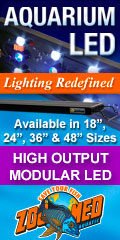I don't want to disrupt your train of thought as it is flowing and I am following with interest.
Just three quick things. Spectroscopy, measurement of light, the interaction of light and matter, mercury vapor UV lamps, lasers, etc. are not foreign to me. It feels like you want to set up a Rayonet UV light reactor in a pipe

something I've used extensively in my grad school and beyond.
22,000 GPH is a huge flow. The system at hand is run by eight pumps, four per each 4500 gal tank and each pump pumps 5000 GPH at the head pressure that I have. So, each tank has four 3" pipes going from the sump to the tank and receives 20,000 GPH. The pumps are in the sump. The water drains by gravity from the tanks into the sump.
I see this is going to be pretty expensive to set up and to run too. It makes me sceptical of when or if I will be able to implement it (we have $5000 in our bank account right now for all our livelihood and business needs, some impending expenses, no debt, and no sponsors anywhere on the horizon) but I much, much appreciate your effort and want to learn it all to the end.
My existing UV sterilizer houses 4' lamp and it cost ~$450 back in 2009. I naively thought that perhaps I could get away with inserting it into one pipe but now it looks like even if I had 8 of them and inserted the UV lights in all 8 pipes, it won't be enough.
Nevertheless, as stated, I want to know it all, if you are willing to go on.
***********************************************************
I agree it looks like a tumor. The best bet at this point is biopsy. Are you in you in Florida? I have an awesome veterinary pathologist down there you can send the sample to.
To finish off the OP theme, today I released both koi into a large natural lake on our property. Perhaps mother nature will heal them... or not. If they survive, and it's a huge if, I might get a chance to recapture them one particularly dry season, when all our ponds and lakes run almost dry.









